Michelle Kingdom creates tiny worlds in thread, to capture elusive yet persistent inner voices.
Literary snippets, memories, personal mythologies, and art historical references inform the imagery; fused together, these influences explore relationships, domesticity and self-perception.
Decidedly small in scale, the scenes are densely embroidered into compressed compositions. While the work acknowledges the luster and lineage inherent in needlework, Michelle uses thread as a sketching tool in order to simultaneously honor and undermine this tradition. Beauty parallels melancholy, as conventional stitches acquiesce to the fragile and expressive.
In this interview, Michelle tells us how she found her artistic voice and developed her technique. We learn about the process she uses to create these intricate, beautiful worlds and she reveals her vision for future work.
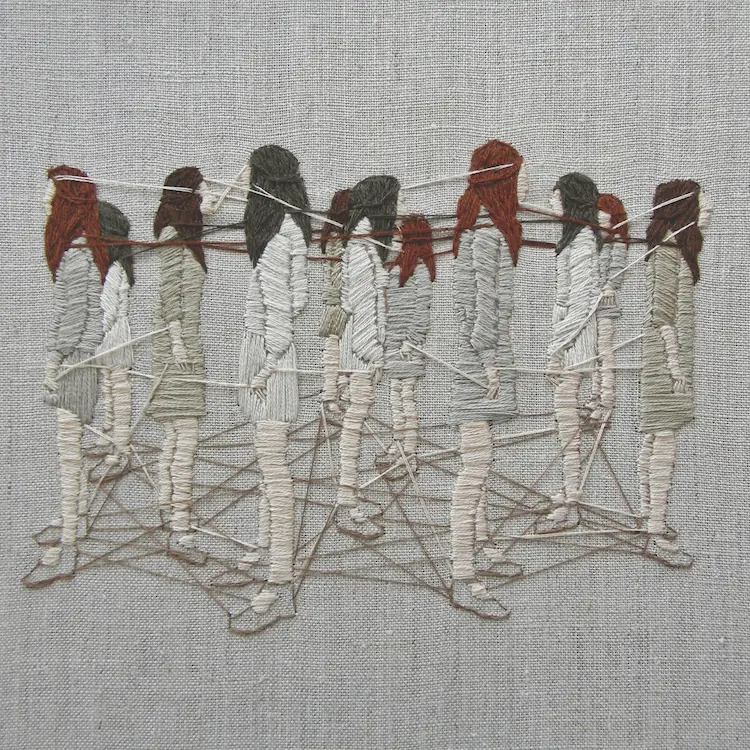
A reaction to art that didn’t speak to me
TextileArtist.org: What initially attracted you to textiles as a medium?
Michelle Kingdom: My initial interest in textiles began while in college in the early 90’s, where I was studying fine art. Back then the art scene felt like an exclusive, closed world. Serious work was oversized, relentlessly ironic, coldly conceptual and impossibly clever. I never imagined there would be any place there for me. At the same time, I grew up in a sewing family where working with needle and thread was familiar and natural. I was drawn to art but also the world of textiles, which I experimented with on my own.
I began drawing with thread and taught myself embroidery as a way to pursue both passions and as a reaction to art that didn’t speak to me. Embroidery became my own private refuge and I never showed anyone my stitching until a few years ago. The effects of embroidery seemed otherworldly and captured my imagination as the perfect way to explore secret thoughts.
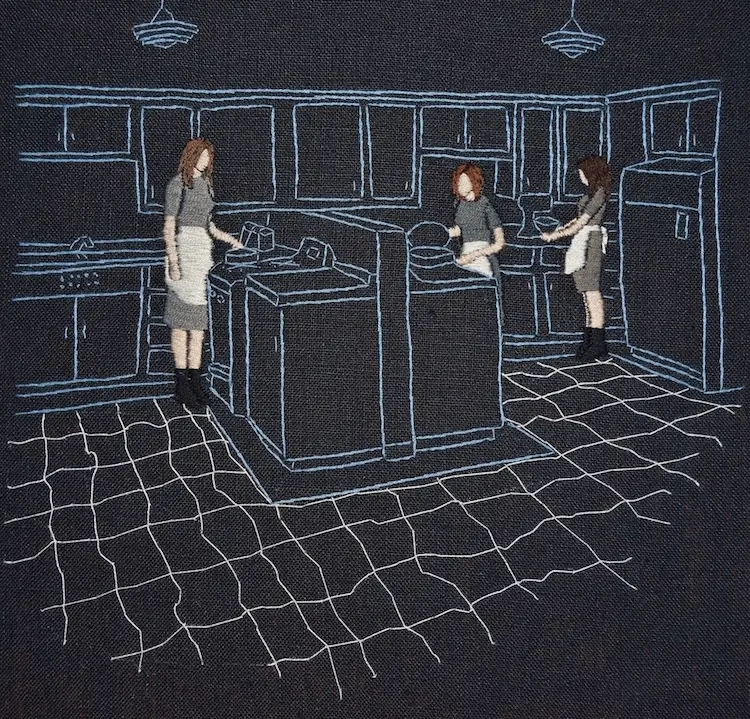
And, more specifically, how was your imagination captured by stitch?
I fell in love with figurative embroidery immediately. While there is an inherent luster and lineage to needlework, it is has a fragile, awkward beauty, which strikes me as compelling, raw and honest. Its tactile quality speaks not only the seamstress in me, but connects me to the memory of so many women with stories buried in thread that came before me.
Embroidery also comes with a lot of baggage. It has often been dismissed and overlooked; perceived as decorative, a school-girl craft, fussily old-fashioned, small. And that is precisely what attracted me to it.
It’s deceptively pretty, unapologetically female, traditional and naive. It speaks in tiny whispers, and only those that care to listen can hear it. My work tries to capture murky ideas brewing around in my head, and the evocative nature of figures in stitch better conveys those ideas than other mediums can.
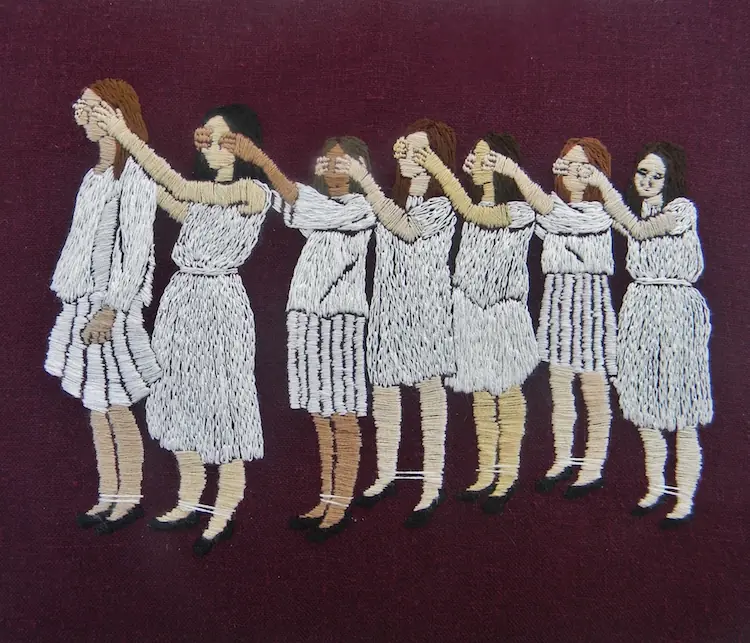
A mounting obsession
What or who were your early influences and how has your upbringing influenced your work?
My artwork is very personal and my family, culture and background have shaped it in every conceivable way. I spent my formative years immersed in 1970’s and 1980’s Los Angeles pop culture. By contrast, my home life was comprised of an extremely close-knit, old world, extended family existence. Four generations lived within a few miles of each other, and some in the same multifamily dwellings.
This dichotomy informed my perspective. As time moved on, I was one of the last to know my immigrant relatives and the family progressively shrunk. We grew more distant, geographically and socially, and essentially assimilated into the modern, lonely nuclear family model. There is a sense of loss in my work, a direct result of this reality.
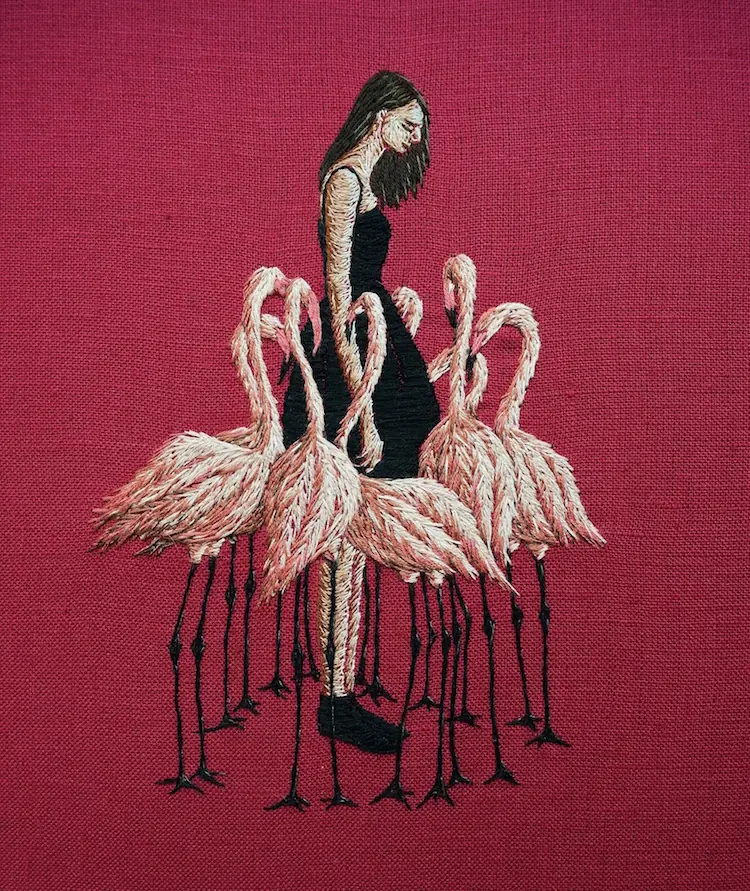
What was your route to becoming an artist?
My story within the arts is fairly oblique. Art was always my main interest, but as I never believed it was a viable career option. I didn’t show my embroideries to anyone and frankly didn’t think anyone would even be interested. I stitched with no intention of having an audience and was making work that reflected the inner dialogue running in my head. Over the years I worked sporadically, frequently sidetracked by adult life.
Around 2010 I began to pursue embroidery with a renewed sense of purpose. Now armed with decades of personal history and my own baggage, the medium seemed more relevant to me than ever. I slowly started to share my work on social media, happily surprised to find that others seemed interested too.
There was no turning back, and my private passion became a mounting obsession. Encouraged by a few close friends, I eventually decided to dip my toe in the water, submitted to exhibit my work, and have been showing ever since.
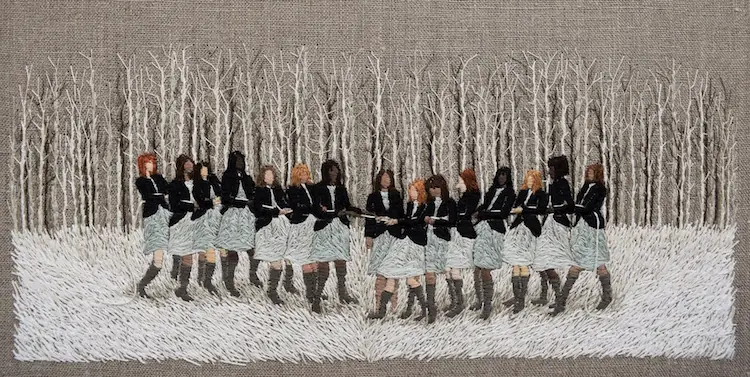
Tell us a bit about your chosen techniques.
My relationship with technique is complicated. Over the years I have developed my own style which is primarily focused on using thread as a drawing tool, retaining a fluid expressive hand, experimenting to further the narrative, and all the while retain an eloquence of skill.
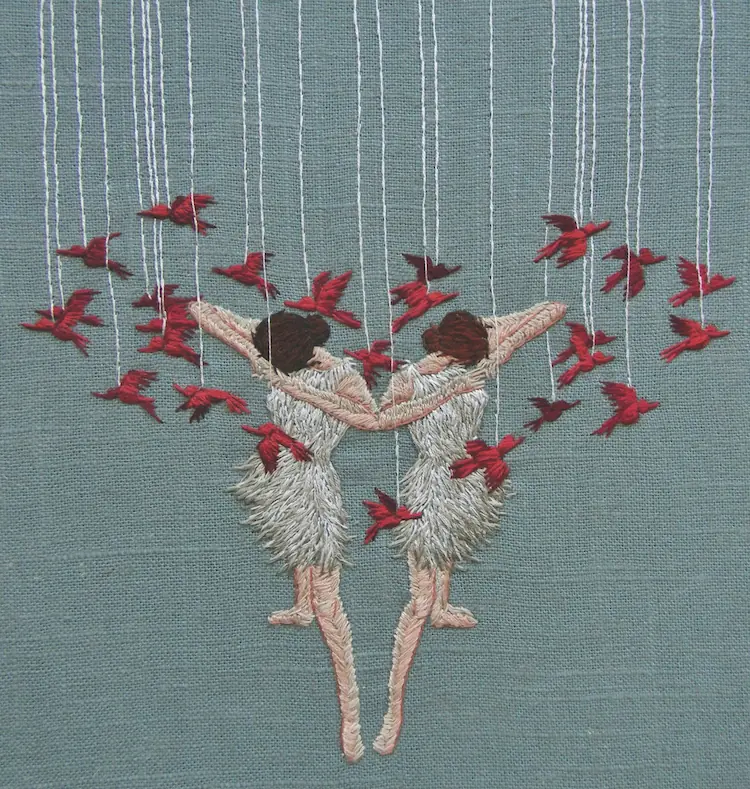
How do you use these techniques in conjunction with embroidery?
My approach to the work is intuitive and there is an ongoing, organic technical dialogue throughout the process. While honoring the richness of tradition, I also try to refresh and bring renewed relevance to the medium.
More and more I find myself moving away from proper stitches, and have ripped out sections of work that feel too beautiful or too stiff. I think most embroiderers will confess to a fondness for the back of the work because its imperfections evoke an authenticity that our conscious artistry is unable to construct.
It is that effect that I aspire to, and I try to approach each embroidery as if it were my first piece. Of course, fundamental art technique is always at play as well by measured use of tone, colour, texture, shadow and composition.
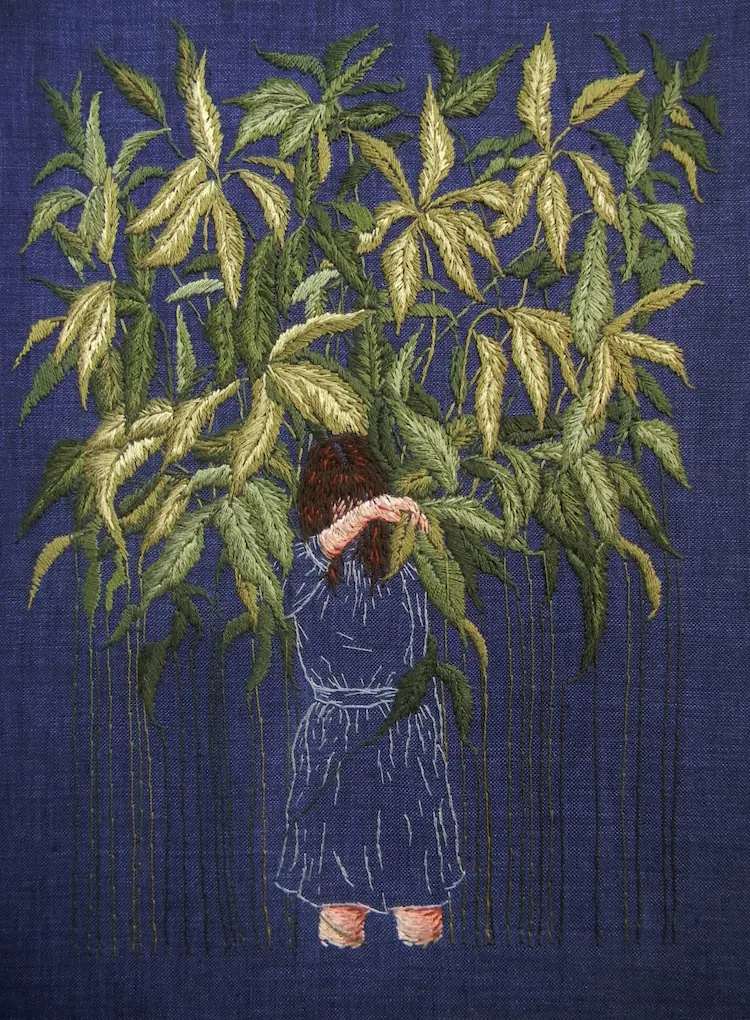
Tiny worlds in thread
How would you describe your work and where do you think it fits within the sphere of contemporary art?
Conceptually I describe my work as an exploration of psychological landscapes. Through these tiny worlds in thread, I hope to capture elusive yet persistent inner voices. I am interested in identity and relationships, and how our perceptions, particularly filtered through the lens of our psyche, shape our reality. The continual tension of opposing dynamics such as aspiration and limitation, expectation and loss, belonging and alienation, truth and illusion, intrigues me.
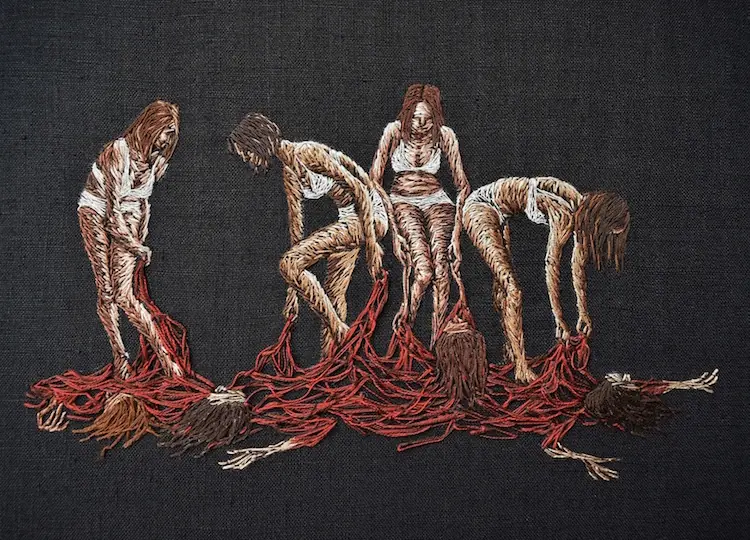
I honestly don’t know where I fit within the world of contemporary art. I’ve been told my work is unique, even unusual, and I’ve exhibited alongside painters more often than fiber artists. Clearly, fiber and textiles have made strides in a contemporary art world that is highly fragmented, saturated and complex.
With the rise of social media and online art communities, maybe I typify a kind of art that doesn’t need to fit within a codified movement.
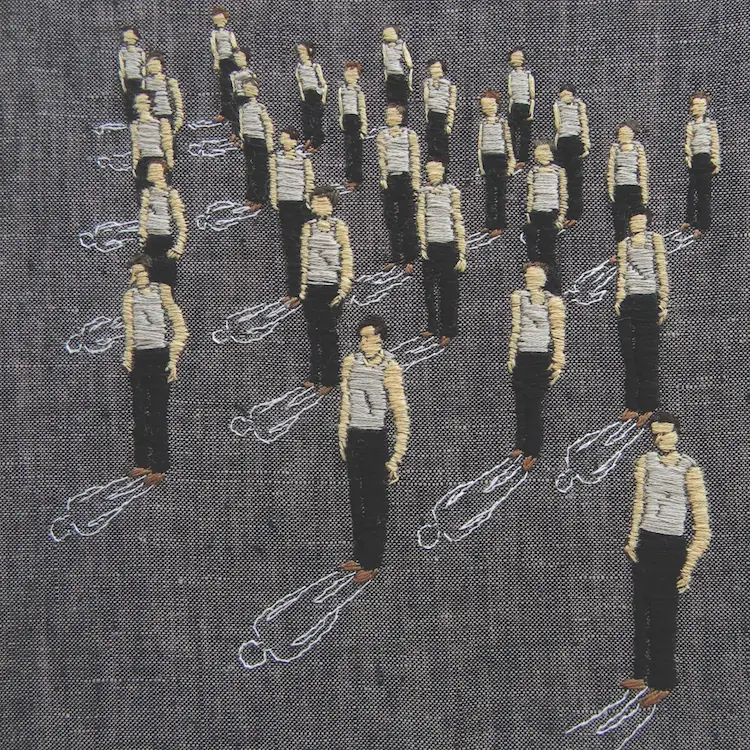
Unexpected discovery
Do you use a sketchbook? If not, what preparatory work do you do?
Yes everything is sketched ahead of time, though not necessarily bound in a book. I use the drawings as an initial pattern and skeletal framework that will continue to evolve during the stitching process.
Tell us about your process from conception to conclusion.
My process has also evolved a lot over the years. Currently I keep tons of sketches and notes. When starting a new piece, I trot them all out and spend a lot of time composing and arranging, almost like a collage.
Once a final drawing is complete, it is transferred with graphite paper to a linen ground. Though I start with a preliminary vision, I make room for experimentation and unexpected discovery along the way. I almost never have a complete image in my head that must be executed exactly. In fact, I don’t think I would bother to stitch at all if that was the case because it is the process that fascinates me.
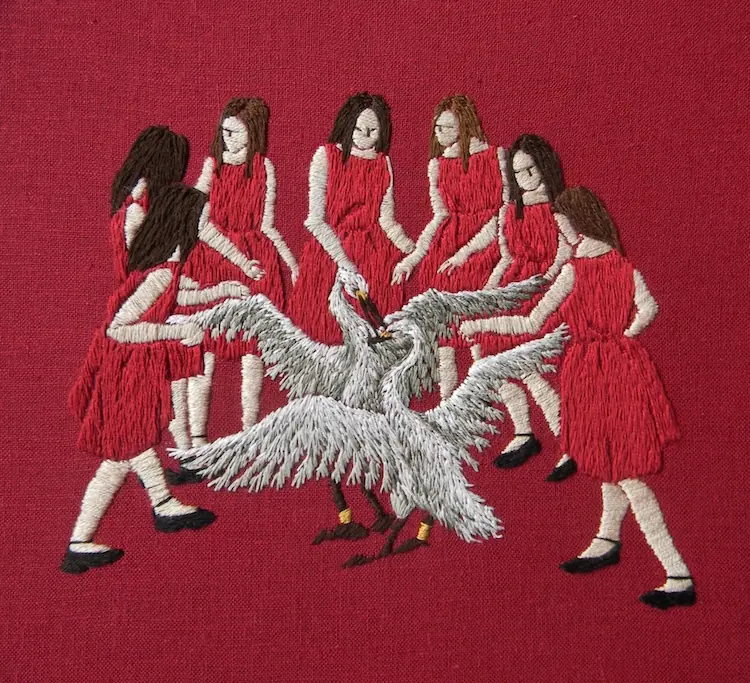
The stitching is usually done with a dense, intuitive, fluid approach and I prefer to draw with thread rather than utilize traditional technique. It is never my intention to make my work imitate drawing or painting though.
After the embroidery is completed, the title must be just right, as it is integral to completing my narrative. Lastly, the embroidery is stretched, finished, and then mounted in a frame.
What environment do you like to work in?
I don’t have a proper studio and work out of my home. The most important element for me is good light and I try to make the most of natural daylight. Living in Los Angeles, this is thankfully fairly abundant, as I have yet to find an artificial light source that is adequate.
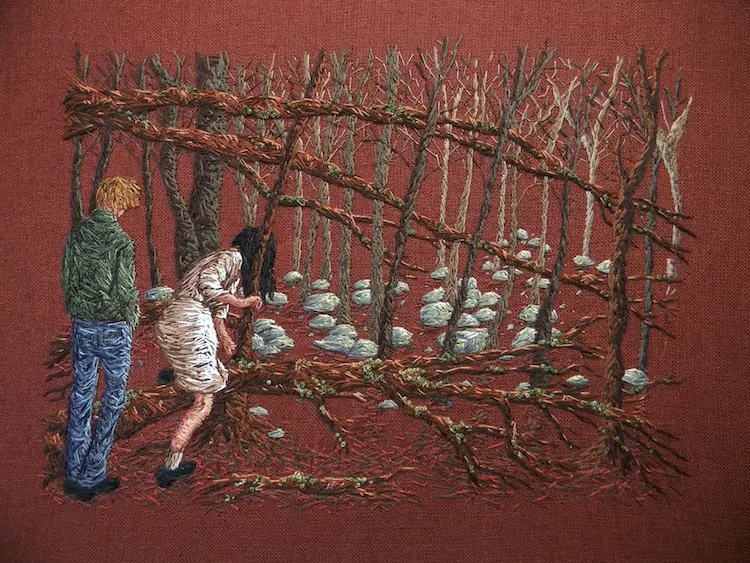
Who have been your major influences and why?
The single greatest influence on my work is Darrel Morris. While still in art school, I remember seeing a tiny photo of his work in the back of an old Fiber Arts Magazine and stopping in my tracks. The image was a close up of a densely embroidered man pointing his finger and yelling what I assumed at the time was something political (I don’t think it was in retrospect). It was strange and raw, yet beautifully rich and powerful. What stunned me was the way he could tell a story with only thread.
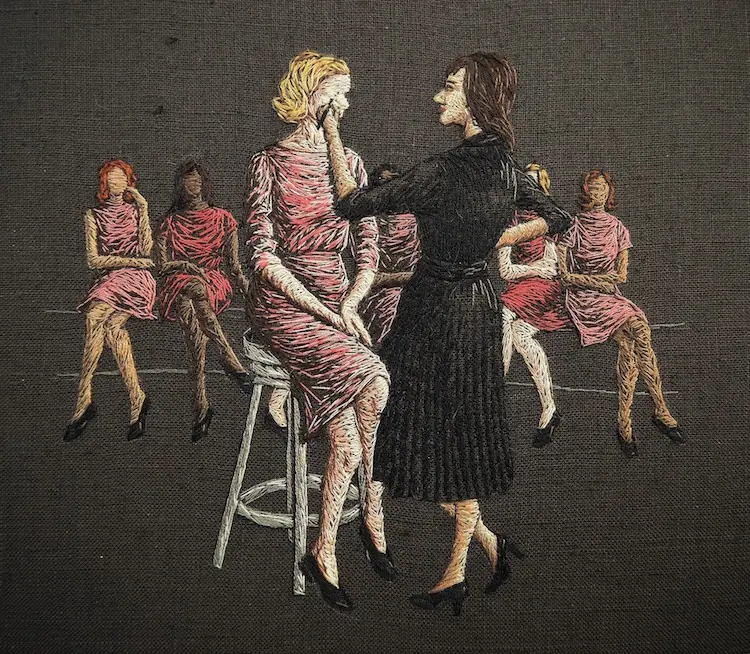
That single image sparked my first efforts and stayed with me for years. A few other textile artists from that time were also major influences including Annette Messager, Ann Hamilton and Magdalena Abakanowic.
The role of literature has also been highly influential on my work. Virginia Woolf stands alone for me but others include Carson McCullers, Leo Tolstoy, Emily Dickinson and Hans Christian Andersen.
Equally, art history is another source of endless inspiration. I tend to gravitate to intimate and visionary artists such as Edouard Vuillard, Stanley Spencer, Henry Darger, Van Gogh, Alice Neel, Gwen John, Francesca Woodman, and Vivian Maier. I’m also very inspired by medieval manuscripts and miniatures, ancient art, symbolism and outsider art.
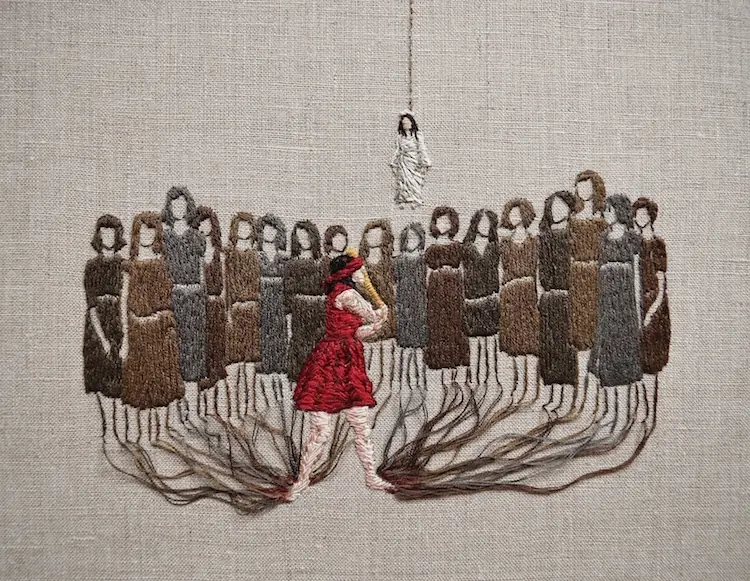
Tell us about a piece of your work that holds particularly fond memories and why?
I view each embroidery as a vignette within a larger body of work, and each one holds its own place for me. That said, ‘The years fell and grew into vines’ from 2013 was a pivotal piece. Inspired by an old family photograph, it evolved into an expressive, personal and experimental work.
It was made around the time I was just beginning to share my work online but it felt like no one was really noticing yet. Among the earliest pieces that I started to exhibit, it became the first embroidery I sold and was also the first work to be published in a print magazine.
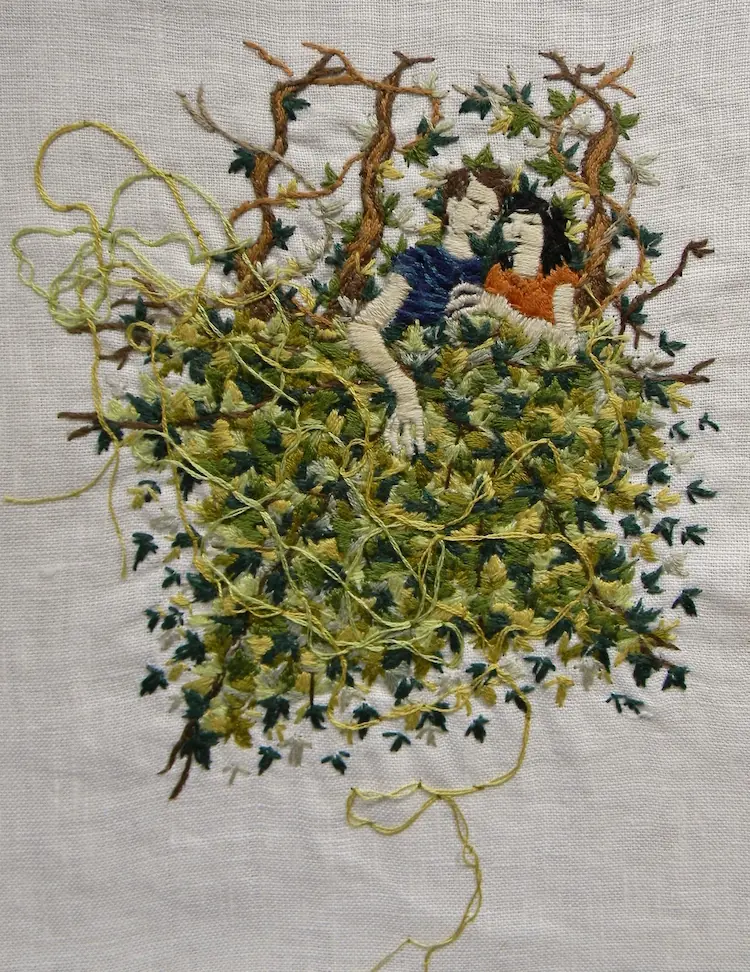
A more investigational style
How has your work developed since you began and how do you see it evolving in the future?
Older work was miniature, densely stitched with sewing thread, and done on tiny silk fragments. Materials and scale have changed somewhat. Though still relatively small, the work is larger (8”x10” or 11”x14”) and almost exclusively in linen and cotton floss. My use of space has changed to become less compressed, and the stitch style is more investigational.
Conceptually my vision has matured and the aesthetic refined. Lately, I have been working with very fine detail, frequently using single strands to achieve delicacy. I don’t know what my next direction will be but I do plan on continuing to evolve.
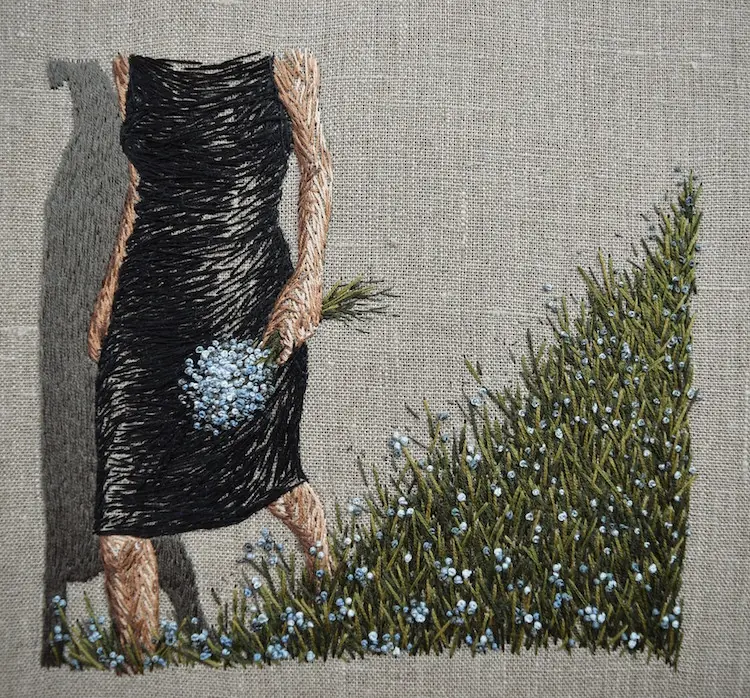
What piece of equipment or tool could you not live without?
I cannot live without my needle threader and have had to acquiesce to reading glasses in the last few years.
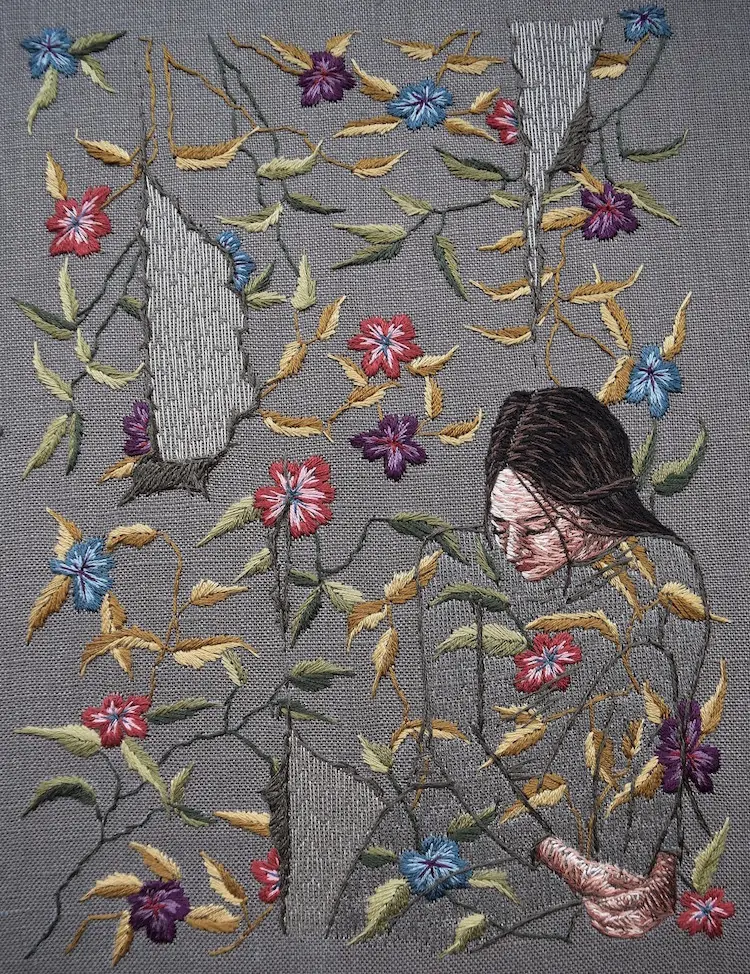
Where can readers see your work this year?
This winter my work can be seen in the Figure 8 exhibit at Foley Gallery in New York and in Stitch Fetish 5 at The Hive Gallery in Los Angeles.
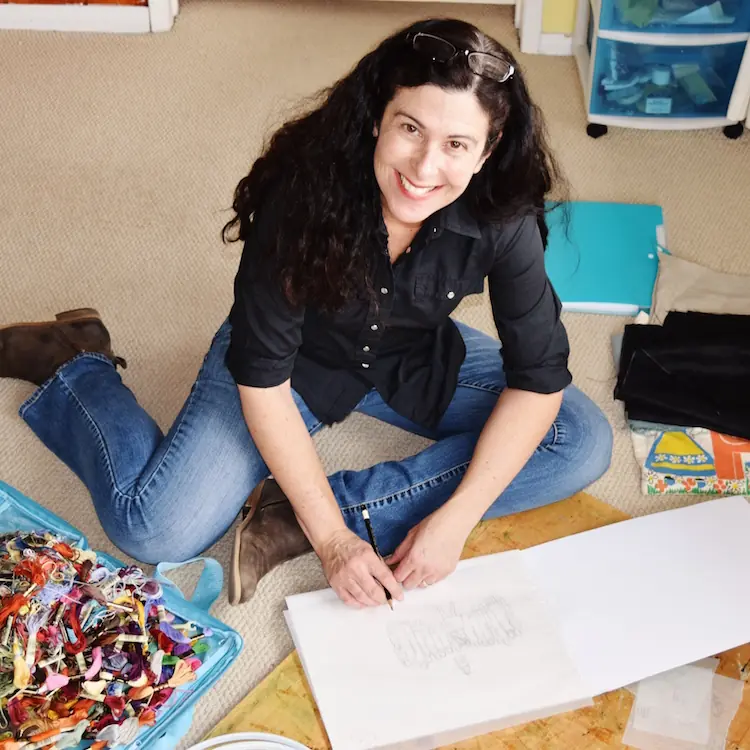
For more information visit: www.michellekingdom.com
www.instagram.com
www.pinterest.com
www.flickr.com
www.facebook.com
www.magcloud.com
www.youtube.com
Let your friends know about this artist’s work by sharing the article on social media. It’s easy – click on the buttons below!
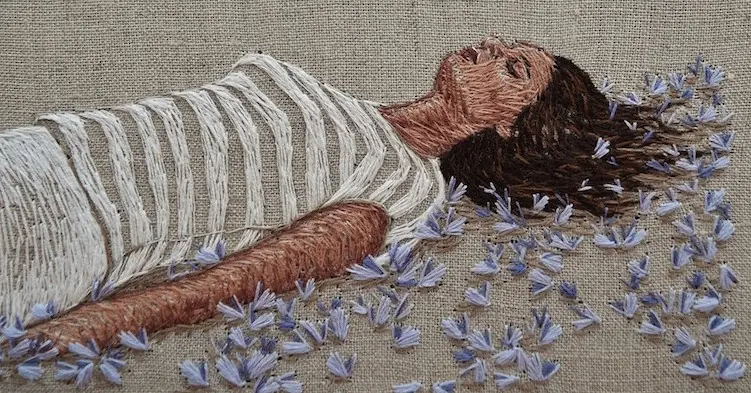
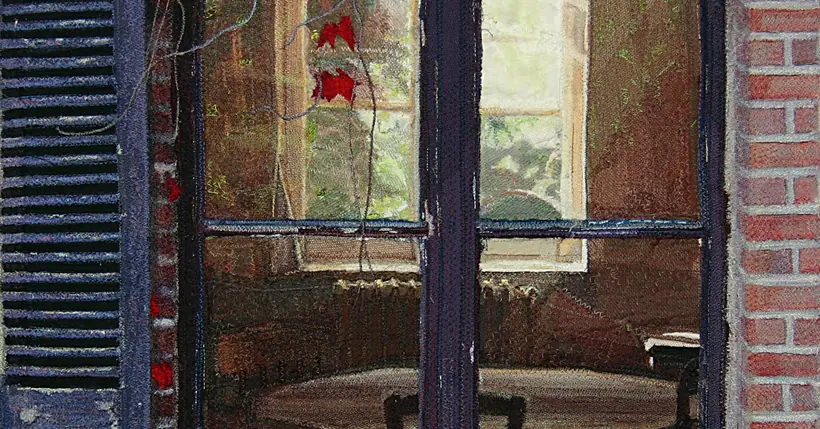
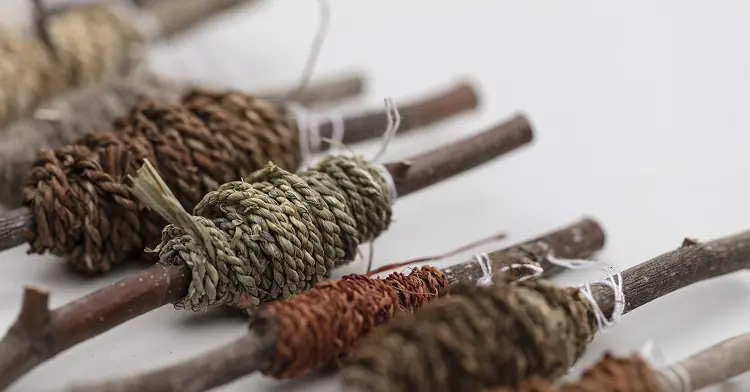
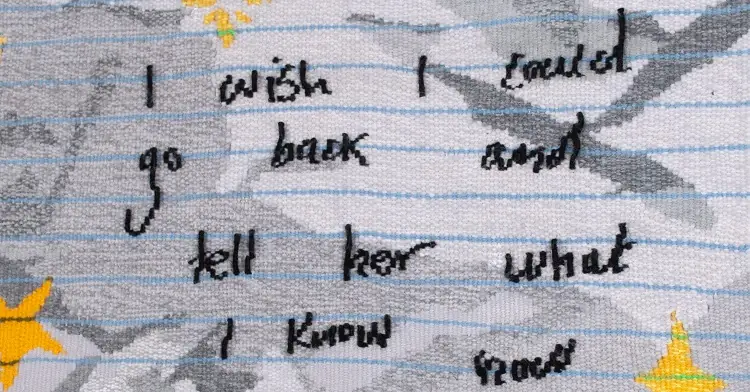
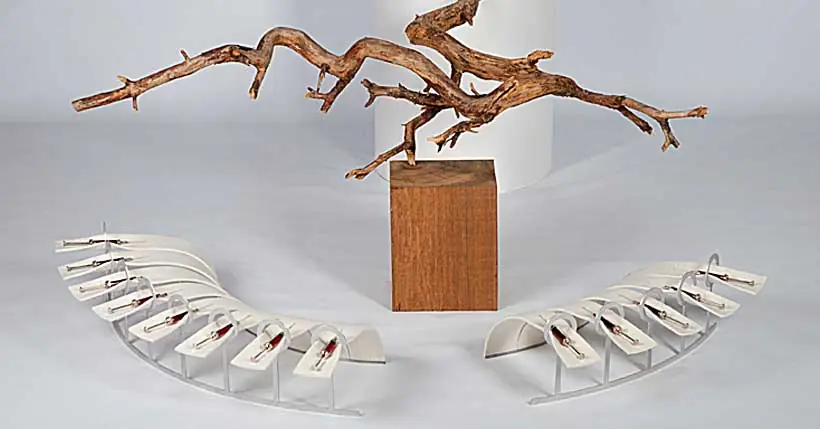
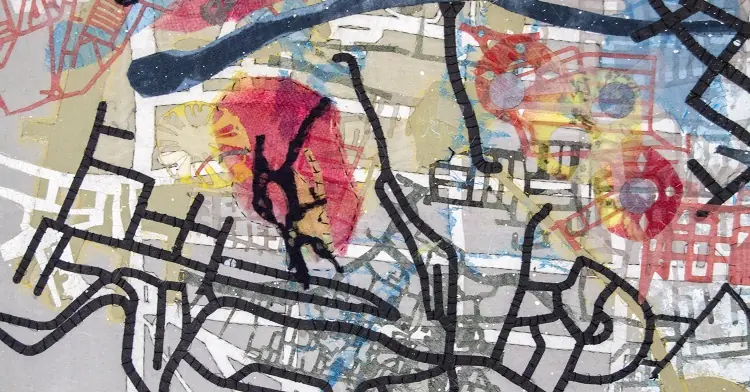
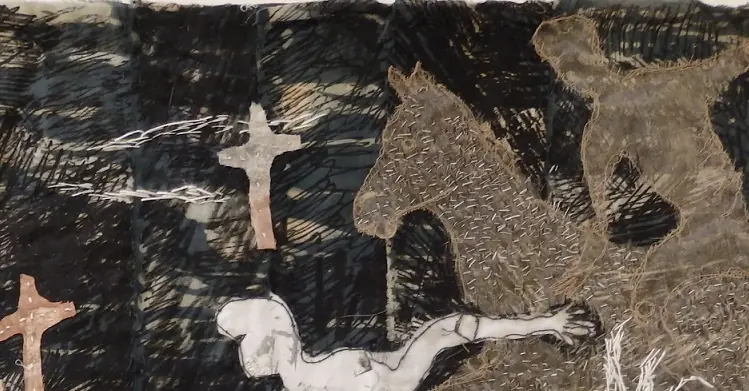
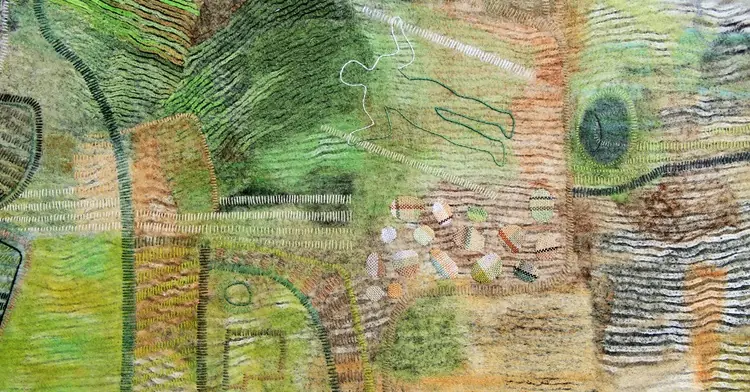
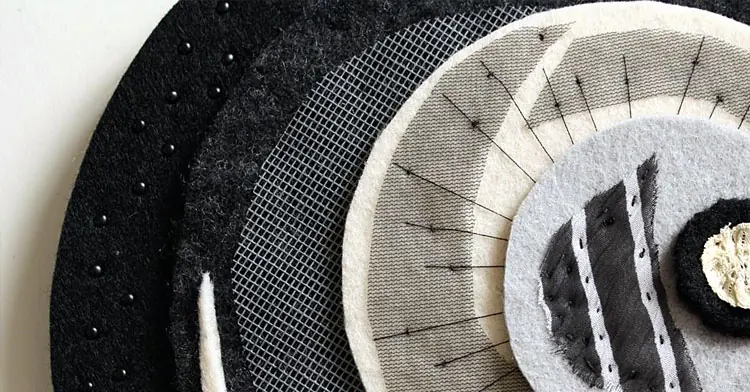
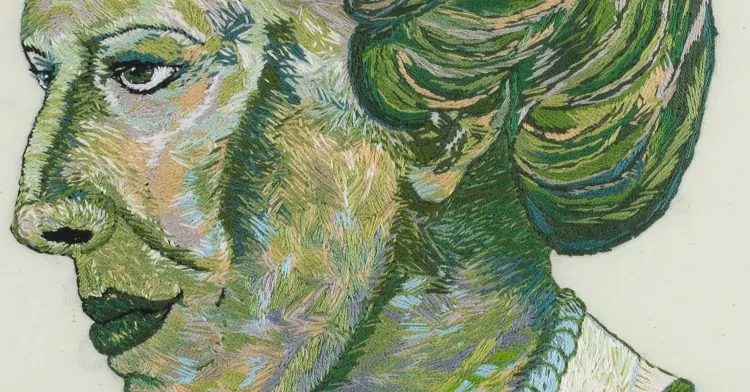
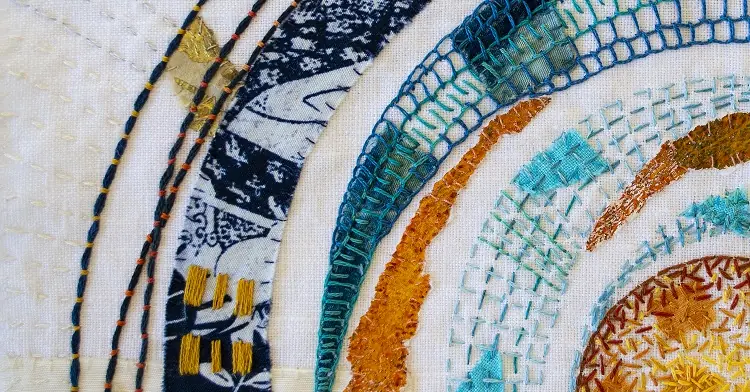
13 comments
Dana Allison
I, too, love working with thread, but not to the extent that this artist does. I prefer to embroider abstract pictures on quilt pieces in the quilts I design to add textural interest, much in the manner of those who worked in this medium back in the Victorian era, using DMC embroidery pearl cotton, sizes 5 and 8. I am amazed that this artist has the patience to be that detailed with thread.
Gail Brokaw
Great interview! Love your work and find it emotional, inviting (like come closer and see what you can find,) and inspiring. Your work involves, for this viewer, examination of my soul, beliefs and feelings.
Margaret Hynds-Ryman
Wow! Totally grabbed me. So striking and readable absolutely grabbed me. Could I do work like that? I’m in a hurry so maybe I should slow down and give it a go.
Terri Bryson
WOW!! I thoroughly enjoyed this article! I look forward to learning more. Thank you!
Natalia
look like mummies
Sabrina Salvioli
Wow very beautiful works! I like them!
Maureen Shepherd
Have not seen this work before. Loved it. Very interesting interview, Glad Textile Artist Org. introduced me to Michelle Kingdom
Clare
I loved this article. i’m feeling quite inspired to get back into hand stitching again. Thank you
Linda Roan
Always been a big fan of Michelle. Glad you showcased her your wonderful newsletter.
Interesting to learn what has influenced her amazing work.
Monika Kinner-Whalen
Michelle, you are as poetic with your words as you are with your art. ♡ I also really enjoyed watching you speak on you tube. Congratulations – always a fan.
Monika Kinner-Whalen
Michelle, you are so potic with your words as you are with your art. ♡ I also really enjoyed watching you speak on you tube. Congratulations – always a fan.
Rachel Biel
Aaahhh…. Such a nice interview. Great to learn more about you, Michelle! You already know that I love, love, love your work! 🙂
I have a question about the Darrel Morris link. I clicked on the link and it took me to drawing, pirate art…. seemed odd, so I did a search and then got embroideries which definitely made sense. I didn’t find a second site. Is the work by the same guy? They sure look completely different…
Daniel
Thank you for your comment and eagle eyes Rachel, TextileArtist.org has rectified this mistake! Our apologies to Michelle. Best wishes, Team TA.